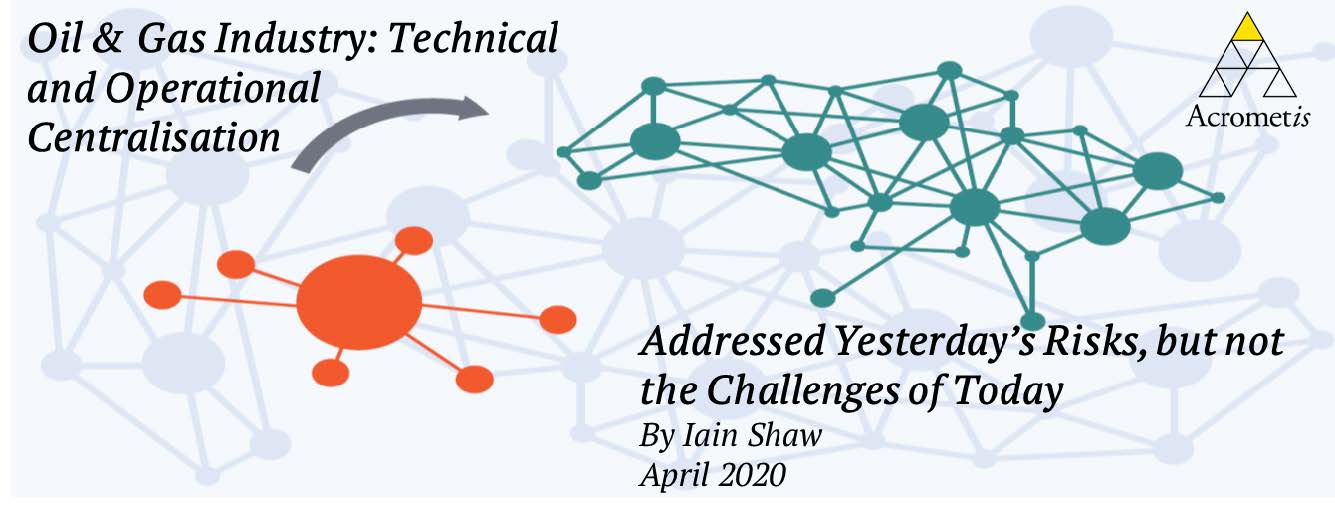
Introduction
From the mid-90’s through to 2010 within the oil and gas industry there was a drive towards centralisation with a six-fold increase in the cost of central organisations. There were legitimate drivers and benefits to this approach at the time but as we look at the industry today is a centralised approach to technical and operations functions the right approach?
Given the industry and economic landscape we would argue that more than ever it is time for optimal operating models that recognise the context in which the operations conduct their business. In our experience the central functions of the past hamper the implementation of the range of optimal operating models often required in larger E&P companies.
Short History of Centralisation
In the mid-90’s the oil and gas industry desire for increased technical and operational centralisation was driven by the industry challenges at that time. The industry faced a resource scarcity both in terms of hydrocarbons and people. Senior executives focused on the hydrocarbon resource challenge, with reserves replacement being a truly decision driving metric. The industry was forced to seek out resources that were increasingly technically difficult to develop in evermore challenging natural, industrial and socio-political environments. The risks associated with these projects required a centralised approach to the management, skills allocation and oversight of these mega projects. With this approach the industry delivered a number of ground-breaking projects such as the Sakhalin Ph2 in Far East Russia, Shah Deniz Field in Baku and the deep water developments in the Gulf of Mexico.
Where We Are Today
The challenges and risks facing the oil and gas industry have materially shifted from those that warranted the centralised approach. With the differing views on how the future of the energy market will evolve reserves replacement is no longer a major driver and capital for exploration and new frontier development is increasingly difficult to get. Major players are now posting their lowest ever reserve life figures and capital markets talk about 8-10 years as a desirable reserves life. This shifts the focus to the Operating Phase where competitive advantage is achieved through efficient operations, maximising recovery of current resources and optimising the use of existing facilities through near-infrastructure developments.
How Has Centralisation Faired?
Many companies had not recognised that the shifting industry risks that had made their centralised approach redundant and combined with the remarkable tenacity for the self-survival powerful central organisations had become untouchable.
In many cases the central functions were dictating common practises based upon their view of what was the generic ‘best way’, often under the guise of operational excellence. More often than not these approaches paid little or no regard to the multiple differing operating environments and contexts. A common approach can be appropriate when assets are operating in similar circumstances or where certain services are common. But within the industry, the diversity of operating contexts had increased significantly. The developments of the past 20 years had introduced a far more diverse set of assets (artic/desert, deep-water / shallow-water, conventional / unconventional, etc) often within one organisation.
The 2014 oil price crash exposed many of the downsides of technical and operational centralisation that had until that point been hidden from view and scrutiny. Central organisations added significant cost burden to assets whilst stifling innovation, slowing decision-making and eroding value. It became clear that the original risk management purpose of centralisation was no longer valid and that companies had centralised functions because they could, had common practises because they could, not because it was the right thing to do.
What has changed
The new industry environment has seen the successful rise of focused-specialist companies that align their operating models with a particular resource type and/or geography. In many cases they have benefitted from acquiring assets from Majors that align with their particular specialisation. In these cases they are reaping the benefits of reduced central organisation overheads and an operating model that is optimised for a particular operating context. It remains the case that some are still riding on the wave of corporate overhead reduction and not fully implemented optimal operating models, but as the industry continues to be challenged by commodity price and the energy transition these companies will become increasingly vulnerable.
How can larger companies maintain scale benefits
In our work with larger companies we do not see that all scale benefits need to be lost in the competition with smaller more nimble specialist companies. Often larger companies have the opportunity to create internal networks of focused specialists working on assets with a particular common context. This means assessing the portfolio as a whole, deciding the strategic grouping for specialisation. At the same time understanding those parts of the asset operating model that require specialisation identifying those that are common and thus can be centrally provided. This exercise must be completed from an asset perspective, the focus must be what is right for the assets. This enables the organisation to leverage scale through connecting networks of focused specialists.
By overlaying this with a set of decision rights that provide assets with the authority to take operational decisions, albeit within some essential boundaries, companies can reduce bureaucracy and non-essential oversight from the centre and free assets to drive their businesses in an agile and entrepreneurial fashion.
How Acrometis can help
Acrometis brings together a strong core team with a range of oil and gas industry leadership, operations, technical and organisational effectiveness skills. We have extensive knowledge and experience of developing and implementing optimal operating models in a wide variety of asset types and contexts. We have successfully implemented a governance framework that enables large E&P companies to have multiple operating models within one organisation.
We would be happy to discuss how we can help you and your organisation with the balance of central and focused support, and how to establish a supporting governance framework.
